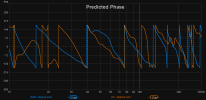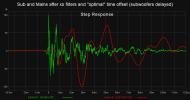Caveat emptor: I do not have GLM, but I'll operate under the presumption that subs will be treated as mono (LR signals as shared input) and time aligned to both (centered) LR speakers.
Step 1 align the IR start times:
Select either both mains or subs and click on 'Align IR start'
This will automatically apply time offsets so IR start positions will be exactly (or almost) the same for both measurements.
Step 2 use the Alignment tool to sum the mains and subs -- separately before mains+sub xo -- or alternatively, use vector averaging (+6 dB offset needs to be applied afterwards):
Notice that the room is causing a phase response difference or skew primarily of the right speaker (red trace) between 90-130 Hz. This will cause a 10-20 dB cancellation dip in the summed LR response.
Step 3 come up with a good enough theoretical target which relieves the mains from heavy bass load burden. Also create a target for the sub that is high enough to assist filling-in the bass cancellation seen the mains.
Step 4 convolve the measurements with the appropriate low-pass and high-pass filters using the Trace-arithmetic A*B function. Since REW can't create these filters correctly (with phase information) on its own, I'll use rePhase to generate the needed filters.
White trace is the imported 48dB/oct 130Hz low-pass filter. Convolve (A*B) this together with the unequalized sub response and you get the predicted (red trace) response.





One can also simulate predictions within REW the individual post filter xo magnitude and phase responses -- however, time offset needs to be applied manually so one would need to be familiar reading phase traces to be able to approximate the alignment for the latter correctly.
**edit: Actually, there is no need to use rePhase for the manual filter(s) creation and convolution step
I completely forgot about this in-built REW functionality -- used it once a long time ago -- and only remembered it now! 
Step 5 finally align the filtered main and sub responses:
I've already applied the appropriate delay offset to the sub response manually beforehand so there is nothing to adjust above.
-----------
Overlay graph views to give you a better idea of what is happening:



I tried other combinations, BTW:
To create some
very simple post alignment EQ within REW, I applied
frequency dependent windowing to the response. If you don't do this beforehand, REW will create too many high Q specific filters.
*Note: if FDW 15 cycles were used, only 3 filters are required, but the correction would be more course/rough.
Remember, I only generated the ff. filters automatically -- and, loaded them to the individual responses as a bonus. If I wanted to be less conservative and more meticulous, I'd apply a few boosting EQ's as well as manually create / re-adjust some of the filters.
GLM could do most of the stuff I showed here, I guess. But this at least gives you an idea how one might determine what's a good xo candidate, time delay offset & EQ simulation using a much more hands-on / manual method.










